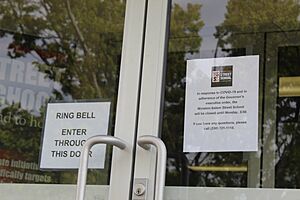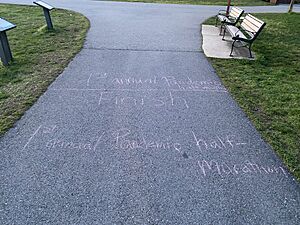Social impact of the COVID-19 pandemic facts for kids
The COVID-19 pandemic caused many changes around the world, not just from the spread of the virus itself. It also had big effects on politics, culture, and how people lived together.
Contents
Political Changes
In China, some local leaders of the Chinese Communist Party were removed from their jobs. This happened because people were unhappy with how they handled the virus outbreak. Some thought this was to protect the main leader, Xi Jinping, from public anger. There were also protests in Hong Kong that grew stronger due to worries about people coming from mainland China.
The United States president Donald Trump faced criticism for his actions during the pandemic. People said he made misleading statements and did not share enough information. He was also criticized for closing a government unit that helped prepare for pandemics. Many believe the pandemic played a part in him not winning the 2020 United States presidential election again.
The government in Iran was also hit hard. Many members of their parliament and other top officials became sick or died from the virus.
Governments and Power
Some experts believed the pandemic would cause big financial and political problems for many countries. They thought it might even weaken a country's ability to govern itself.
Rules and Rights
In April 2020, the UN Human Rights Chief warned that governments should not use the pandemic as an excuse to stop people from speaking out or to stay in power longer. About 80 countries declared some form of emergency. In some places, like Hungary, the prime minister was given special powers to rule without the usual checks.
Working for Peace
The pandemic seemed to make some conflicts worse. Because of this, the United Nations asked for a worldwide ceasefire. On March 23, 2020, the UN Secretary-General António Guterres asked for all fighting to stop. Many countries supported this idea. On July 1, 2020, the UN Security Council passed a resolution asking for an immediate stop to fighting everywhere. They also asked for a long break in conflicts to allow humanitarian aid.
School and Learning
The pandemic greatly affected schools and universities around the world. Many closed down completely. By March 25, 2020, schools in 165 countries were closed nationwide. This affected over 1.5 billion students, which is 87% of all students globally.
Many universities moved classes online instead of stopping them. A study of students found that many worried more about their mental health during this time. Also, many people without internet access struggled to get healthcare and education.
COVID-19 and Fairness
People with lower incomes were more likely to get sick with COVID-19 and to die from it. In big cities like New York City, poorer neighborhoods had more cases. This might be because poorer families often live in more crowded homes. They also often work in essential jobs like supermarkets or elder care, which meant they couldn't work from home.
In the United States, many low-income people did not have health insurance or enough insurance. Millions lost their health insurance when they lost their jobs. Many service workers also became unemployed.
While many people started working from home, this was only possible for a small group. Workers with higher education, often in office jobs, could work remotely more easily.
Religious Changes
The pandemic changed religious practices in many ways. Worship services were canceled, and religious schools closed. Big religious gatherings and festivals were also called off. Many churches, synagogues, mosques, and temples offered online services instead.
Religious groups also sent medical supplies and help to affected areas. People of many faiths prayed for the pandemic to end. In the United States, President Trump even named March 15, 2020, a "National Day of Prayer."
Healthcare and COVID-19
The pandemic had a big impact on healthcare. Healthcare workers faced huge challenges. They had to deal with more patients, less space, and a lot of stress. They also sometimes lacked enough protective gear.
Nurses, for example, felt more confident in their skills during the pandemic. They saw their job as very important and felt proud of their work. They also realized how much support patients needed to cope with their illness. At first, nurses felt tired and stressed. But as time went on, they felt more grateful and reflected on their experiences.
Healthcare delivery also changed. Many doctors started offering virtual visits instead of in-person ones. This was mostly successful, even though some people still preferred seeing their doctors face-to-face. Healthcare workers felt a shared responsibility and faced new fears, like getting infected themselves. Training and support helped them deal with these fears.
Quarantine Time
There was a lot of discussion about how long people should quarantine after being exposed to COVID-19. The recommended quarantine time in the United States changed from 14 days to 10, then 7, and even 5 days. Researchers studied the risk of spreading the virus after quarantine. One study found that after 7 days, the risk was about 13%. However, some people can still spread the virus for a shorter or longer time. Different types of the virus also had different levels of spread. For example, the Omicron type was very contagious on day 5. More research is needed to decide the best quarantine time.
How People Felt
On March 18, 2020, the World Health Organization shared advice on mental health during the pandemic. They talked about how to handle stress and worry.
Some people worried that pets might spread the virus to humans. This made some people hesitant to keep their pets. However, in the United Kingdom, many people actually got more pets during the lockdown.
Fear of the Virus
Researchers identified a new fear called "coronaphobia." This is when people have an extreme fear of catching the virus. This fear can make it hard for them to do their daily activities.
Social Life
The virus and lockdowns changed how people socialized. Many felt anxious about being in crowds or doing things they used to do before the pandemic. People became hesitant to share physical space with strangers. This led to new ways of interacting and even jokes about "post-COVID dating."
Getting Together
The pandemic had a big impact on personal gatherings. Health experts advised people to stay home, and local governments often made rules against gatherings of any size. This included not just big events but also smaller get-togethers.
People found new ways to connect, like using video calls for meetings or parties. Some even had "birthday parades" where cars drove by to celebrate. Finding ways to stay connected was important for people's mental health.
Care for Older People
Older people were especially affected by COVID-19. They needed special care and attention during the crisis. Their thoughts and worries were important for planning how to help.
Older people living in nursing homes or care facilities were at a higher risk of getting sick. Older people who lived alone sometimes struggled to get information, food, or medicine during lockdowns. They needed support from family, healthcare workers, and volunteers.
People with Disabilities
People with disabilities faced a higher risk of getting COVID-19 and dying from it. This was especially true for those with intellectual and developmental disabilities. Data from the United States showed they were four times more likely to get COVID and twice as likely to die. This is partly because many live in care facilities where the virus can spread easily. They also might have other health problems that put them at higher risk.
People with disabilities were also more likely to feel lonely or stressed during the pandemic. School closures created many problems for children with disabilities. They often missed important physical and occupational therapies. Many tools they used for learning were not compatible with online classes. Also, many children with disabilities live in poverty and might not have internet access for remote learning. These children also faced worries about food and delays in their development.
See also
- Shortages related to the COVID-19 pandemic
- Xenophobia and racism related to the COVID-19 pandemic
- Distance learning
- Social impact of the COVID-19 pandemic in the Republic of Ireland
- Social impact of the COVID-19 pandemic in the United Kingdom
- Social impact of the COVID-19 pandemic in the United States




